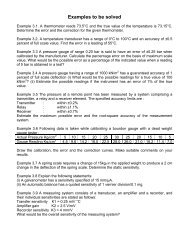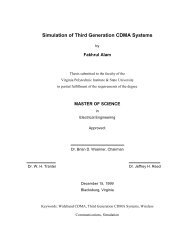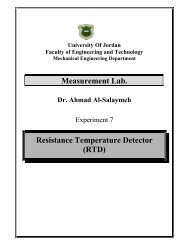Communications I Dr. Mohammed Hawa Introduction to Digital - FET
Communications I Dr. Mohammed Hawa Introduction to Digital - FET
Communications I Dr. Mohammed Hawa Introduction to Digital - FET
You also want an ePaper? Increase the reach of your titles
YUMPU automatically turns print PDFs into web optimized ePapers that Google loves.
clocking is important in digital systems as all digital receivers require the existenceof the clock <strong>to</strong> function properly (this is similar <strong>to</strong> the synchronous detection processin DSB-SC demodula<strong>to</strong>rs).(b) Another advantage is <strong>to</strong> the ability <strong>to</strong> control the DC component in the resultingline code. This is important because most long-distance communication channelscannot transport a DC component 6 , and hence, most line codes try <strong>to</strong> eliminate theDC component before being transmitted on the channel. Such codes are called zero-DC or DC equalized.Other advantages of proper line coding include the (c) possibility of transmitting at ahigher data bit rate while requiring smaller bandwidth for the resulting basebandsignal, (d) the possibility of increasing the average power of the baseband signalcompared <strong>to</strong> noise (i.e., improving SNR), and (e) reducing the amount of power atlow-frequency components of the spectrum, which is important in telephone lineapplications, where the channel exhibits heavy attenuation below 300 Hz.Some types of line encoding in common-use nowadays are unipolar, polar, bipolar,Manchester, MLT-3 and Duobinary encoding. These codes are explained here:1. Unipolar (Unipolar NRZ and Unipolar RZ):Unipolar is the simplest line coding scheme possible, but the least used in practicedue <strong>to</strong> its many disadvantages. Unipolar coding uses a positive rectangular pulsep(t) <strong>to</strong> represent binary 1, and the absence of a pulse (i.e., zero voltage) <strong>to</strong> represent abinary 0.Two possibilities for the pulse p(t) exist 7 : Non-Return-<strong>to</strong>-Zero (NRZ) rectangularpulse and Return-<strong>to</strong>-Zero (RZ) rectangular pulse. The difference between UnipolarNRZ and Unipolar RZ codes is that the rectangular pulse in NRZ stays at a positivevalue (e.g., +5V) for the full duration of the logic 1 bit, while the pule in RZ dropsfrom +5V <strong>to</strong> 0V in the middle of the bit time. The figure below shows the differencebetween Unipolar NRZ and Unipolar RZ for the example bit stream 1110110001001.ClockData 1 1 1 0 1 1 0 0 0 1 0 0 1Code0T 0Bit timeT sSampling time (assuming 8 bits per sample)Unipolar NRZ Code6 DC-values create excessive heat generation in the channel, they cause baseline drift and also do notfit systems that carry an additional small direct current <strong>to</strong> power intermediate amplifiers (an exampleis telephone networks).7 Actually there are so many possibilities for the pulse shape p(t); not just a rectangular NRZ orrectangular RZ pulses. Changing p(t) waveform is called Pulse Shaping and affects the characteristicsof the line code as will be explained later.8
















